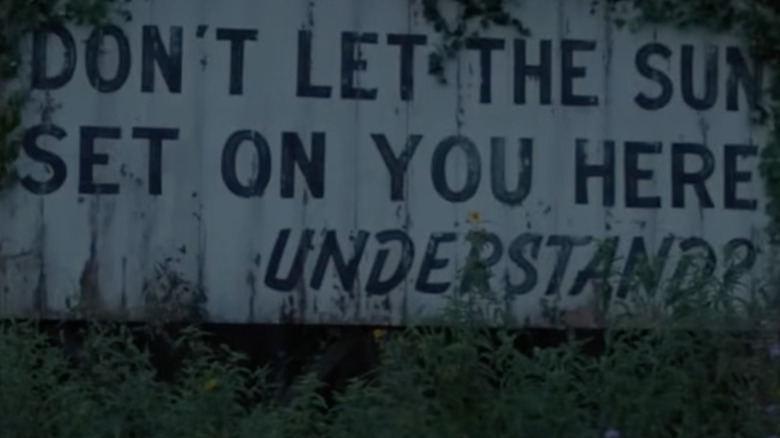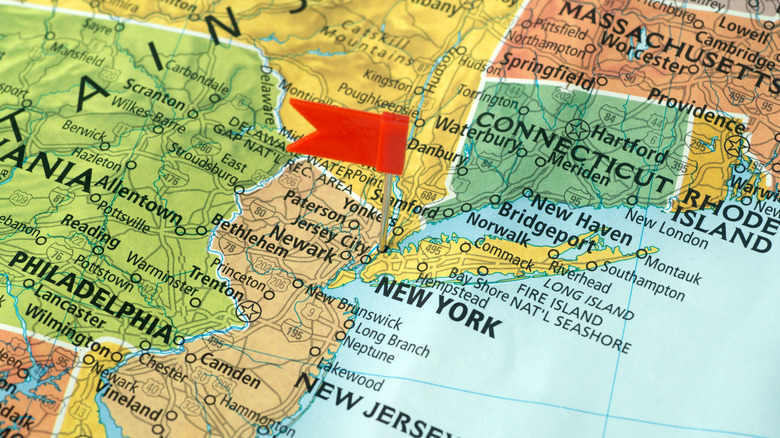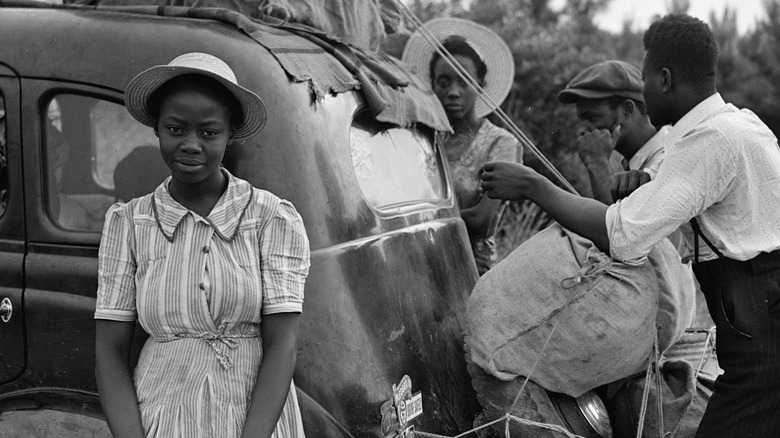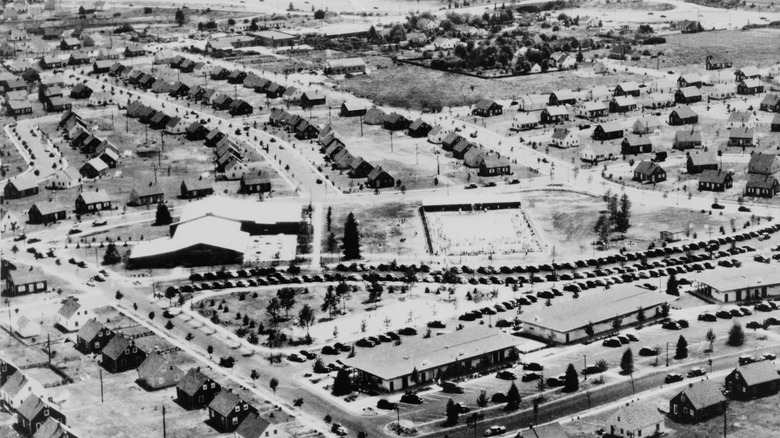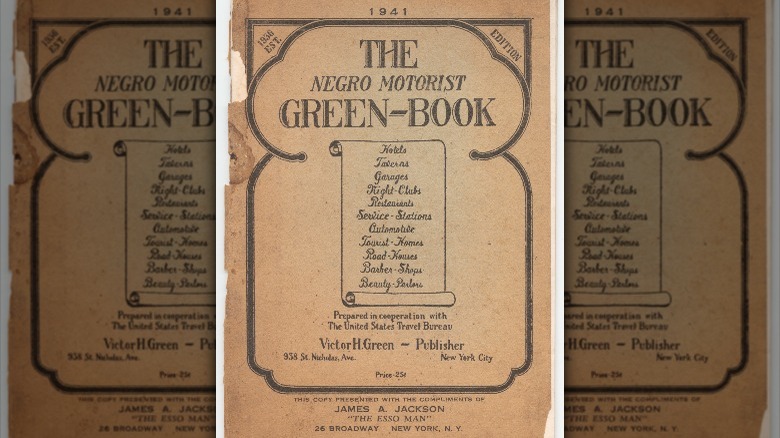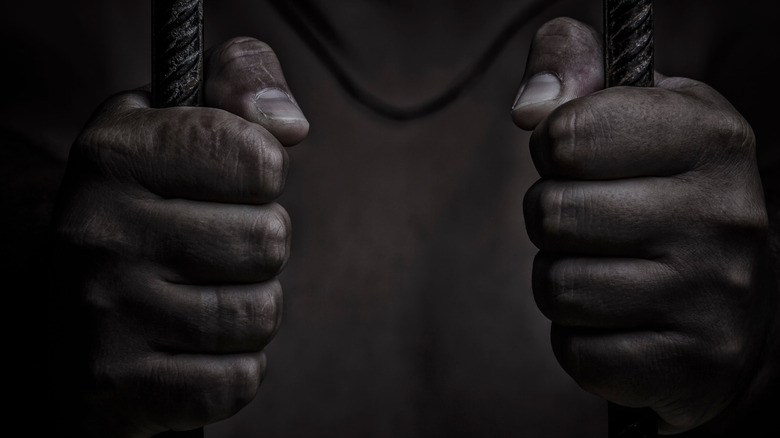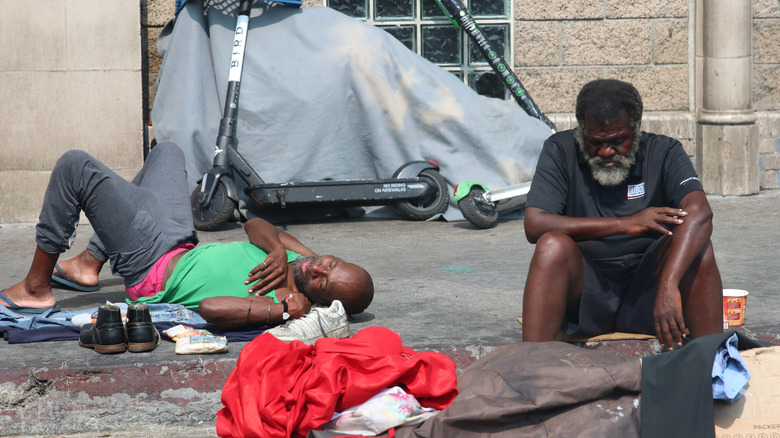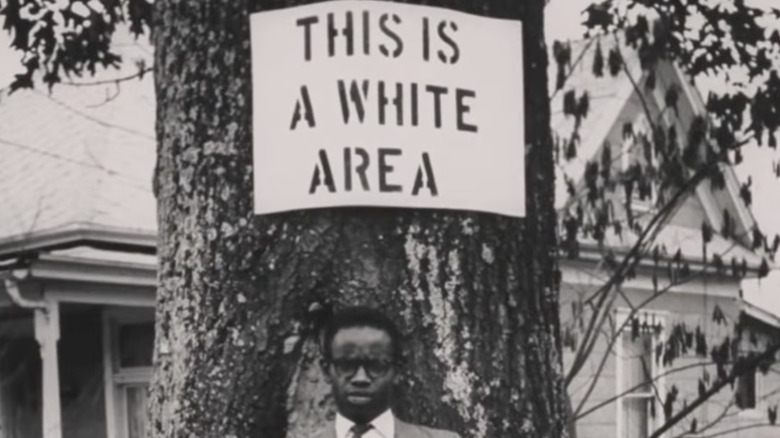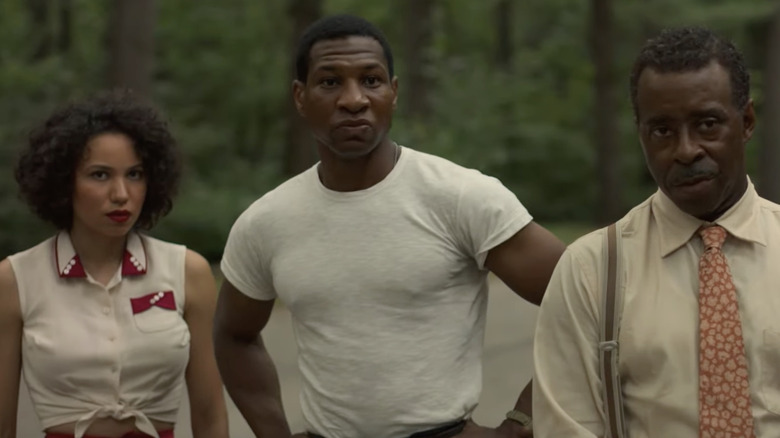The Disturbing Truth About Sundown Towns
A sundown town is defined as any community that was deliberately established to only allow white residents. The term does not just describe townships, as it can also be extended to larger areas like an entire county or simply restricted to neighborhoods in a city. The late James Loewen was an expert in studying the history and occurrence of these majority-white communities, which he detailed in his 2005 book "Sundown Towns: A Hidden Dimension of American Racism," as per Tougaloo University.
Sundown towns have existed in America for more than a century and persist today due to a delicate combination of tradition and reputation, as per the Associated Press. There are still locations where residents of these segregated communities are openly hostile to people of color and thus retain their majority white populations.
Some experts argue that sundown towns are a relic of America's racist past. Even so, younger generations of people who live in these communities are slowly beginning to question their white supremacist histories and are working to dismantle the segregation that has continued for decades.
It is important to note that a community with a majority white demographic is not necessarily a sundown town. There is always nuance to how a town conducts itself both past and present. Here is the disturbing truth about sundown towns.
The origins of sundown towns
According to All That's Interesting, sundown towns appeared in America as early as 1759, when a law in New Hampshire stipulated that non-white individuals were banned from traveling the area at night (unless they were servants or enslaved to a white household and were running errands). However the prevalence of sundown towns can be traced back to the Reconstruction Era in the South around the 1890s and Jim Crow laws establishing segregation at the beginning of the 20th century.
James Loewen explains sundown towns had invisible borders called "dead lines" that defined where Black people were allowed to live (via Investigation Discovery). He said they could exist as a county line or the limits of a city or township. This exclusion was enforced through laws and often through violence and intimidation tactics.
In extreme cases, individual states attempted to ban non-white residents. Oregon is one of these states and ironically is home to one of the most progressive cities in America. The Washington Post reports that, in 1844 (15 years before declaring statehood) all Black people whether free or enslaved had to leave Oregon Country. For nearly the next decade the territory would pass laws excluding Black people from settling in the territory. When Oregon achieved statehood in 1859, it had already established in its Constitution that Black people were not legally allowed to reside or own land within its borders.
Many of these towns were in Northern States
It's easy to assume that all white towns demanding people of color left after dark are concentrated down south. They were (and still are) scattered across the whole country, notes James Loewen in "Sundown Towns: A Hidden Dimension of American Racism." Interestingly, several sundown towns in the North suffer from an interesting characteristic: It's harder to determine their status. According to Loewen, many town residents may not even know the original catalyst that created them.
Two towns in Western New York — Tonawanda and North Tonawanda — are located along the former Erie Canal. During the canal's heyday, many African Americans were employed to operate the boats. According to locals Loewen interviewed, no one was sure what caused Black people to be driven out of the area, just vague memories about an alleged crime a Black man committed. As of 2010, the population of both Tonawanda and North Tonawanda remains more than 90% white.
In a similar vein, the Boston Globe reports that not only does Groton, Massachusetts, currently host a nearly all-white population, but it also used to be home to a branch of the Ku Klux Klan. Loewen, as well as local government authorities, were unable to definitively prove Groton's status as a former sundown town. Its history of white supremacist activity is not enough to prove the deliberate exclusion of non-white people, and as such, residents are still grappling with its racist legacy.
Changing demographics from the Great Migration
The Great Migration was a mass exodus of African Americans who left the South in the early part of the 20th century. Many people gathered their families and prized possessions to resettle in the North, across the Midwest, and the West Coast. According to Smithsonian Magazine, this migration was fueled by a desire to escape menial labor, restricted voting rights, and lynchings.
James Loewen writes in his book, "Sundown Towns: A Hidden Dimension of American Racism," that World War I slowed the immigration of Europeans and increased international demand for American products. This caused a large influx of African Americans to flow into northern cities. Loewen writes that before the Great Migration, a Great Retreat was happening in smaller towns and counties in the Midwest. White people had been driving Black people out of their communities as far back as 1890 before they began seeing significant populations emerge from the South.
Prior to the Great Migration, nearly 90% of African Americans were living in southern states, and by 1970 the demographics reflected that 47% of Black people were spread between the North and West. The second generation born to these transplants were granted opportunities that would not have been accessible had their families remained in the South.
However, these successes were gained in the face of hostility. Many racist and discriminatory policies from the South followed African Americans to their new homes. This often meant being banned from living in white neighborhoods.
Ties to the rise of suburbs
The rise of suburbs is linked to sundown towns due to white flight, which to this day facilitates non-white people being concentrated in specific communities. According to the Washington Post, white flight is a phenomenon associated with the mass relocation of white populations out of cities into suburbs following World War II. Experts are learning this began during the Great Migration, but white people at the time moved to all white neighborhoods within the city.
In an interview with NPR, author Richard Rothstein explains what later fueled segregated suburbs were Federal Housing Authority (FHA) subsidies. Levittown, New York, was one of these beneficiaries. However, it was redlining that kept African Americans out of the suburbs. Vox reports the FHA would refuse to back loans for Black people who lived in redlined neighborhoods. Redlining covenants eventually started the incorrect assumption that Black people would bring down property value.
Many of these suburban communities were explicitly marketed as being whites only, such as Levittown. The idea was conceived by William J. Levitt, who built and sold homes to ex-soldiers returning from deployments in Europe. These mass-produced single-family homes began being sold in 1947, as per Long Island Press, but they came with a racist stipulation written into the lease: Only white people could purchase a Levittown home, and only white people were permitted to occupy the house. The only non-white individuals allowed to reside in Levittown homes were domestic servants.
The Green Book was created to avoid these towns
Road trips were an iconic part of American culture. In the 1950s the highway system brought access to famous landmarks and national parks. Many people today might even yearn for the nostalgia of a family drive down Route 66, but like so many slices of Americana, not everyone got to enjoy road trips.
African-American travelers hoping to enjoy the open roads faced unknown dangers and exclusion. The Atlantic reports Route 66 stretches 2,440 miles and had 44 counties with sundown towns along it in 1930. Leaving home did not entail the same freedom for Black people — they needed to meticulously plan their route, and they did so armed with "The Negro Motorist Green Book."
The Green Book helped travelers avoid harassment and potentially violent encounters by providing detailed information on safe lodging, gas stations, hair salons, restaurants, and other services in each state. It was created by Victor H. Green, a postal worker and travel agent (via Vox). Starting in 1936 Green gathered information on African American-friendly establishments in New York City. He eventually branched out, acquiring information on businesses across the country.
The publication was updated annually and sold approximately 15,000 copies. With the passing of the Civil Rights Act in 1964, businesses were no longer legally permitted to exclude people of color, thus the Green Book went out of print.
Consequences of overstaying in sundown towns
Ignoring the warnings to stay out of sundown towns could lead to punishments of varying severity and depended on how strict the community enforced the rule. For example, James Loewen reveals in "Sundown Towns: A Hidden Dimension of American Racism" that Syracuse, Ohio, maintained strict enforcement of its whites only after dark policy. If an African American was found lingering inside the borders of the town at dusk, a mob would harass the individual by throwing stones at them and heckling them as they ran until they were beyond the town's limits.
However other communities did not take such a mild approach. In many cases, townspeople became violent — such as in 1968 in Martinsville, Indiana. Kieth Beauchamp reported in Investigation Discovery that 21-year-old Carol Jenkins was stalked by two men after she was caught walking on the streets late one September evening. Jenkins was aware of the town's status as unwelcoming to Black people but had gotten separated from her carpool of coworkers.
Jenkins found refuge in a couple's apartment, however she decided to leave despite their insistence to stay the night. The men eventually caught up with Jenkins and stabbed her in the heart, leaving her to die in the street. The couple that sheltered Jenkins was harassed in the days following her murder. Her case remains unsolved.
Sundown towns are part of broader inequalities
Some experts suggest that sundown towns contribute to economic inequalities in addition to residential discrimination. Heather A. O'Connell wrote in the journal Sociology of Race and Ethnicity that the existence of sundown towns served to not only physically separate white people from Black people but also to distance Black people from social, economic, and natural resources. It's why African American and other minority communities are more likely to live in polluted areas, as per The Atlantic.
Redlining helped corral minorities into urban neighborhoods and directly impacted their ability to establish intergenerational wealth, as per NPR. Housing discrimination persisted even after the Fair Housing Act was passed in 1968. This also caused the schools in African American neighborhoods to decline in quality, since the housing tax pays for the schools in their district. NPR reports higher value homes can fund better schools with higher quality educational programs.
To get an idea of how this ties into economic inequality and segregated communities, consider the "Moving to Opportunity" program of the early 1990s. The federal government conducted an experiment where they randomly split more than 4,000 families into three groups: One was given Section 8 vouchers to live anywhere they wanted, another could only use their voucher in wealthy neighborhoods, and the last group would stay in public housing. Researchers found the children of the participants who moved to wealthy neighborhoods earned far more than those who continued to live in public housing.
Modern examples of sundown towns
There are a few sundown towns that have received negative press in light of activists shedding more light on police brutality and the rise in white supremacy groups being more outspoken. Vidor, Texas, Anna, Illinois, and Vienna, Illinois, are three towns that to this day remain nearly 100% white.
African Americans say they notice the cold attitudes towards outsiders. Anna, Illinois, has a particular reputation for being unwelcoming towards Black people. According to ProPublica, locals say the town's name, Anna, is also an acronym for, essentially, no Black people allowed. Some Black residents in the surrounding area reported not feeling safe in Anna, and some say they have received derogatory comments while in the town.
About 20 miles east of Anna is another sundown town called Vienna. It once held a small population of Black people prior to 1954, as per the Associated Press. The street residents once called home was burned to the ground and has been abandoned ever since. Much like in Anna, its non-white residents feel a sense of passive aggressive tension. For example, one Black resident said he is constantly watched, while a biracial teen reported a similar experience of being stared at.
Texas Monthly reports, in the 1990s, Vidor, Texas, tried unsuccessfully to integrate by relocating a small group of Black tenants to a housing project. The tenants all moved out of town after relentless harassment and threats of violence. As of 2020, it seems Vidor is working to improve relations.
Criticism over modern existence of Sundown Towns
Some experts believe James Loewen's research is overstating the severity and prevalence of sundown towns. After he released "Sundown Towns: A Hidden Dimension of American Racism," two historians argued against the evidence Loewen presented.
According to the Washington Post, one historian, Andrew Wiese, took issue with Loewen's definition of sundown towns, stating it was too broad and fused housing discrimination with racist tactics to expel Black people from towns. Another historian and sociologist, Thomas J. Sugrue, argues Loewen's research relies too much on hearsay through oral histories.
However, second generation sundown towns are now reckoning with their past, and it is being met with resistance. Loveland, Colorado, is experiencing this, as NPR reports the city council in 2019 wanted to expand equity measures to make it more diverse. White residents have pushed back and argued there is not a race problem and, ironically, the issues are arising because of discussion about the city's past racist history.
Interestingly, when given the choice, white homebuyers will more often than not choose to live in areas with higher concentrations of white people (via the Atlantic). Realtors also continue to funnel people towards neighborhoods with similar races. The 2015 article from the Atlantic reveals white flight is still happening, and it is pricing some minority communities out. Municipal authorities are resistant to mixed income housing in some cities, which could desegregate once inaccessible neighborhoods. In the end, they tend to yield to wealthy white property buyers.
Mentions in popular culture
Recently more movies and TV have brought more attention to sundown towns and similar racists practices. Several storylines have explored the frequent and often dark injustices perpetrated in 20th century America — take for example the 2019 HBO miniseries "Watchmen." A major plot point recounts a character surviving the Tulsa race massacre in Oklahoma, which was once home to a Black middle class.
Other media have been exploring sundown towns directly, including the 2018 movie "Green Book" starring Viggo Mortensen as the bodyguard-driver, Tony Vallelonga and Mahershala Ali as jazz pianist Don Shirley. The movie takes its name from the previously mentioned "Green Book for Negro Motorists," yet it makes a small appearance in the film despite the fact it would have been essential for the character's travels, according to Vox. The film shows Shirley and Vellelonga encounter all levels of racism–some of which could have been avoided if they used the Green Book. There is also a scene where Shirley gets arrested for being in a sundown town pass curfew.
HBO's "Lovecraft Country" featured an example of hostility Black people faced by staying overnight in a sundown town. The first episode follows Atticus Freeman, his uncle, and his friend as they search for his missing father. The trio confronts a police officer who informs them they could be killed merely for driving around town after hours. Media Entertainment Arts WorldWide reports this is likely many white audiences' first introduction (in recent memory anyway) to the concept of a sundown town.

